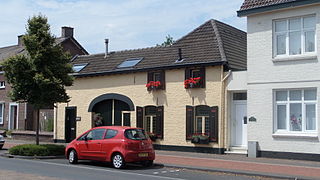
Brunssum is a municipality and a town in the province of Limburg in the Netherlands. The municipality of Brunssum has 27,670 residents as of 2021.

Maastricht is a city and a municipality in the southeastern Netherlands. It is the capital and largest city of the province of Limburg. Maastricht is located on both sides of the Meuse, at the point where the river is joined by the Jeker. Mount Saint Peter (Sint-Pietersberg) is largely situated within the city's municipal borders. Maastricht is adjacent to the border with Belgium and is part of the Meuse-Rhine Euroregion, an international metropolis with a population of about 3.9 million, which includes the nearby German and Belgian cities of Aachen, Liège, and Hasselt.

Limburg, also known as Belgian Limburg, is a province in Belgium. It is the easternmost of the five Dutch-speaking provinces that together form the Region of Flanders, which is one of the three main political and cultural sub-divisions of modern-day Belgium. As of January 2024, Limburg had a population of 0.9 million.

Brunssum is a municipality and a town in the province of Limburg in the Netherlands. The municipality of Brunssum has 27,670 residents as of 2021.

Heerlen is a city and a municipality in the southeast of the Netherlands. It is the third largest settlement proper in the province of Limburg. Measured as municipality, it is the fourth municipality in the province of Limburg.

Roermond is a city, municipality, and diocese in the Limburg province of the Netherlands. Roermond is a historically important town on the lower Roer on the east bank of the river Meuse. It received town rights in 1231. Roermond's town centre has become a designated conservation area.

Sittard-Geleen is a municipality in the southeastern Netherlands. It was formed in 2001 from the former municipalities Sittard, Geleen and Born.

Weert is a municipality and city in the southeastern Netherlands located in the western part of the province of Limburg. It lies on the Eindhoven–Maastricht railway line, the A2 motorway and it is also astride the Zuid-Willemsvaart canal.

Thorn is a city in the municipality of Maasgouw, in the Dutch province of Limburg. It lies on the rivers Meuse and Witbeek. It is known as 'the white city' for its white-washed brick houses in the centre of town. It used to be part of the Imperial Abbey of Thorn.

Echt-Susteren is a municipality in the southeastern Netherlands. Echt-Susteren was created in 2003 by merging the former municipalities of Echt and Susteren.

Hasselt is the capital and largest city of the province of Limburg in the Flemish Region of Belgium.

Sint-Truiden is a city and municipality located in the province of Limburg, Flemish Region, Belgium, and has over 41,500 inhabitants, which makes it one of the largest cities in Limburg. The municipality includes the former communes of Aalst, Brustem, Duras, Engelmanshoven, Gelinden, Gorsem, Groot-Gelmen, Halmaal, Kerkom-bij-Sint-Truiden, Melveren, Metsteren, Ordingen, Runkelen, Velm, Wilderen, and Zepperen.

Maaseik is a city and municipality in the Belgian province of Limburg. Both in size and in population, it is the 8th largest municipality in Limburg. The town is the seat of the administrative arrondissement of Maaseik (kieskanton). Internationally, Maaseik is known as the assumed birthplace of the famous Flemish painters Jan and Hubert van Eyck.

Geleen is a city in the southern part of the province of Limburg in the Netherlands. With 31,670 inhabitants in 2020, it is part of the municipality of Sittard-Geleen. Geleen is situated along the river Geleenbeek, a right tributary to the river Meuse. The Latin name for Geleenbeek is Glana, meaning "clear river". The town centre is situated at about 60 m above sea level.

Nieuwstadt is a city in the Dutch province of Limburg. It is a part of the municipality of Echt-Susteren, and lies about 5 km north of Sittard. Nieuwstadt received city rights in 1277.

Spaubeek is a village in the Dutch province of Limburg. It is located in the municipality of Beek, about 3 km south of the town of Geleen. Spaubeek was a separate municipality until 1982, when it was merged with Beek.

Koningsbosch is a village within the municipality of Echt-Susteren, in the Dutch province of Limburg. Koningsbosch is located next to the German border, approximately 10 kilometres east of the town of Echt.

Grevenbicht is a village in the south-eastern Netherlands. It is located in the municipality of Sittard-Geleen, Limburg, about 8 km north-west of Sittard, on the east bank of the Meuse river.

Munstergeleen is a village in the Dutch province of Limburg. It is located in the municipality of Sittard-Geleen, and it lies in the Western Mine Region.

The Geleenbeek is a river in Limburg, the Netherlands. Its source is near the village Benzenrade, part of the city of Heerlen. It flows generally northwest, along Nuth, Schinnen, Spaubeek, turns north at Geleen, flows through the centre of Sittard, and further north through Nieuwstadt until it flows into a branch of the Meuse at Stevensweert.




























